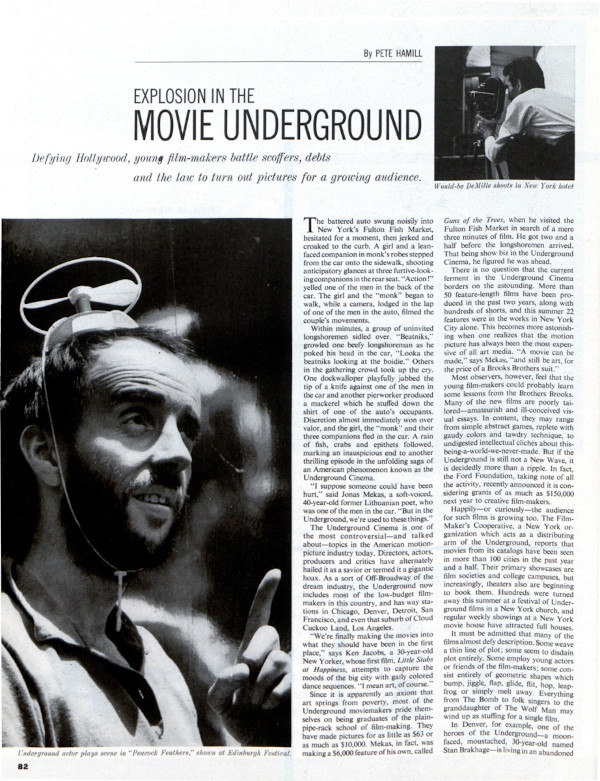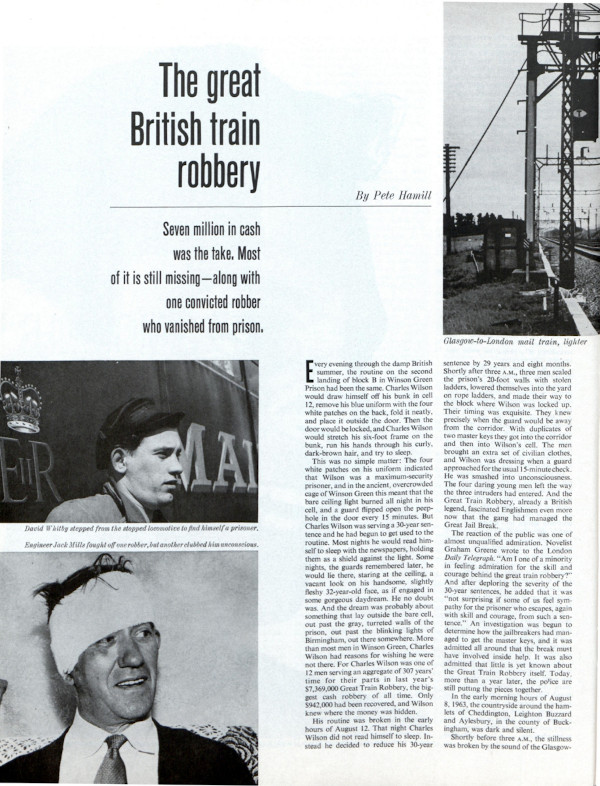Legendary journalist Pete Hamill died yesterday at age 85. The illustrious writer was described as a “quintessential New York journalist” for his decades of work in The New York Post, The Daily News, The Village Voice, Esquire, The New Yorker, Playboy, and The Saturday Evening Post. He published short stories and novels too, along with a memoir and books of essays.
In newspapers, Hamill became known for his plainspoken columns, giving on-the-ground perspective of culture and justice in his home city. For this magazine, he travelled Europe in the early ’60s, sending back celebrity profiles and stories of crime and labor disputes.
Hamill’s knack for skillfully undressing New York City was clear in one of his earliest stories for the Post, “Explosion in the Movie Underground,” printed on September 28, 1963. Years before the New Hollywood era of cinema was declared, Hamill documented the experimental filmmakers working on the streets of New York. He was skeptical of some of the “amateurish and ill-conceived visual essays” that were being produced, but he described the guerrilla directors and their makeshift moviemaking with the kind of sincere, closeup reporting that was a hallmark of his work.

In another Post story, “The Great British Train Robbery” (September 19, 1964), Hamill covered the largest (at the time) cash robbery of all time, in which 15 men stopped a Royal Mail train and took off with more than 7 million dollars. He detailed the puzzling case of the 1963 Great Robbery and subsequent “Great Jail Break” that left British police scratching their heads and the public oddly impressed and intrigued.

Journalists and editors mourned Hamill’s passing. New York Daily News columnist Mike Lupica tweeted “As Pete once said of another New Yorker, it’s like a hundred guys just left the room,” and former New York Times writer Clyde Haberman tweeted “the world just became a far less interesting place.” Daily News reporter William Sherman wrote in an e-mail that Hamill was about the fastest writer he ever saw: “He had an preternatural understanding of the city and its people from the top hats on Fifth to the longshoremen on 12th at the River. He knew how to listen, which he advised us beginners as most important.”
In a phone call, Gay Talese recalled meeting Hamill while covering prizefighter José Torres in the late ’50s. “I’ve been living in New York for 75 of my 88 years,” he said. “I’ve known so many different writers, from poets to playwrights to journalists, and Hamill was a combination of all of those things, and he had the capacity for and time for friendship. I felt he was one of my best friends.” Talese said that Hamill’s life crisscrossed the lives of both the writing profession and nightlife: “I knew him when he was and wasn’t drinking and I couldn’t tell the difference because he was always a nice guy … he lived an extraordinary life.”
Hamill expressed his opinions on the Post in no uncertain terms soon after it folded in 1969 in a column in The Village Voice. He had visited the deserted offices on Lexington Avenue and gave a close account of the magazine’s downfall: criticism coupled with credit where credit was due for what he saw as the interesting work done in the ’60s. “At the end,” he wrote, “with the magazine collapsing around them, the Post editors finally saw fit to commission Norman Mailer to write something for them. It will never be printed by the Post.”
Hamill’s journalistic world of pounding out copy on a typewriter and throwing cigarette butts on the floor may be long over, but his intense passion for the truth, and his tendency to take to the streets to find it, is a lasting inspiration in every newsroom.
Featured image by David Shankbone, edited via the Creative Commons Attribution-Share Alike 3.0 Unported license, GNU Free Documentation License, Version 1.2.
Become a Saturday Evening Post member and enjoy unlimited access. Subscribe now




Comments
Impressive feature on this legendary journalist, Nick. I read the links first and am sorry about the pain and suffering he went through in his last days. I’d like to read ‘The Explosion in the Movie Underground.” 1963 was still several years before ‘New Hollywood’ (1967-1976) came on the scene, ushered in with “Bonnie and Clyde” and out with “Network” both with Faye Dunaway*.
I can tell in the Village Voice feature his emotions over the newly cancelled Saturday Evening Post were like an open wound, with a lot of bitterness and anger, especially when writers were continually having their work destroyed or drastically altered. As a writer that had to have been horrible, and he was there; we weren’t. I think Hamill was right when he said he didn’t think they knew who their audience was anymore!
I’ve read (and have) the 1970 book ‘Decline and Fall’ by the final managing editor, Otto Friedrich, from 1962-’69. The book reveals facts of the secret diary he kept of an almost Gothic tale of the accelerating collapse of a great publishing empire complete with midnight plots, moral dilemmas, betrayed friends and ruined careers.
The fact is, The Saturday Evening Post was in a place not unlike the 1890’s when it effectively died, but was saved so it could ‘reinvented’ by Cyrus Curtis from a newspaper to the beginnings of its decades long run of unimaginable heights and success. It always managed to change with the times, with the first real ‘threat’ coming in 1936 with LIFE magazine. It was given a facelift in 1942, including a new logo, and was doing well until 1961.
In the ’60s, facelifts, new formats no longer worked. Television was sucking away the ad dollars big time. The issues were thin, frequency cut to a bi-weekly in 1965 like Collier’s had done in 1953, 3 years before it ended. Many of the Post’s covers (frankly) were almost interchangeable with Look’s. It was trying to emulate Look in a desperate attempt to save itself. It couldn’t BE Look and it had lost its identity as the Saturday Evening Post, both.
This is NOT to say the Post was wasn’t still putting out A LOT of great issues! Indeed they were, and on a lot of stories and editorial features LIFE and Look were not, for whatever reason. Time would be kinder to the ’60s issues than the time in which they were produced. Look what a blast they are to read and look back on now, and how they’ve enriched this website, and will continue to, right?!
The fight for ad dollars between print and TV was bloody and brutal. In 1968 Marty Ackerman became the president of Curtis and apparently was planning on killing it by mid-year. Instead, he cut the circulation and revamped it including a new logo that had ties to the old time horizontal. There were some spectacular issues that year including the Laugh-In Girls and ‘Happy’ by Sister Corita Kent. I’m sure the only reason the first 2 issues of 1969 were published is because they were completed before the ’68 Holidays. They pulled the plug after New Years, which was kinder than when Collier’s had the plug pulled on it shortly before Christmas 1956.
The Post may have been first to get the ax, but LIFE and Look would both be gone before 1973. They were down to little more than liquor and cigarettes that couldn’t be advertised on TV. Postal rates and paper costs were steadily rising, creating the opposite situation of the economics these magazines were based. I have a LIFE in the other room from ’72 where the cover price was only 50 cents, and the subscription card says ‘Send me 23 weeks of LIFE for only $3.87’ (less than 17 cents per copy).
Fortunately for the Post, Beurt SerVaas saved it, reinventing it almost 50 years ago with its identity restored on a new economic basis to circumvent TV and anything else. Unlike TV, the computer with this website has only enhanced the Saturday Evening Post general-interest experience to being daily, complementing the bimonthy magazine perfectly.
I’d like to think that if Pete Hamill were to have had a chance to look at the ’60s issues of the magazine within the past few years again, he’d see them through new eyes and (if not love them the way we do) at least feel they were really good issues considering all of the obstacles they were facing then.
*One of my favorite covers of ’68! 🙂